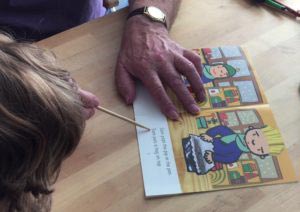
Guest post from James Lyra
Recently on the various Dyslexia Support pages, there have been many questions about ‘decodable’ books. Here is my take on the topic.
Technically, every written word in the English language is decodable, because every written word is a symbolic representation of the spoken word i.e. letters are symbols (created by us humans) to represent the sounds in our speech. Hence, all texts are decodable.
The trouble is, that over the last few millennia our written English code has evolved with a massive complexity of spellings for the 44 phonemes (sounds) in our spoken language. Some have suggested up to 300. Think of the sound /or/ – there are 13 different spellings. So many words that beginner readers need to read, have complex code in them.
When we talk about ‘decodable’ books, we are actually talking about books where the text has been phonically controlled to only include words with code knowledge in a specific sequence. These texts also include ‘high frequency words’. This ensures that the beginning reader can practise using the code knowledge that they’ve learnt, by reading words with that code, in the context of sentences and stories – thus making the process meaningful, relevant and in many cases enjoyable.
At the start of any phonic sequence, the amount code taught is small; hence the words and sentences are limited. However, as the child progresses through the sequence, they have more access to the code (spellings of the sounds) and thus the ‘phonic controlled’ books/texts/readers become more detailed and complex.
THE KEY TAKEAWAY: If using ‘phonic controlled’ books/texts/readers, it is important that the child taught in a systematic manner the code sequence to match the books. Otherwise, the child’s reading accuracy may be reduced which could lead to frustration and other issues.
This does not mean that individuals / schools can only use one brand or type of phonic controlled reader. It simply means adults may need to exercise careful judgement when using ‘phonic controlled’ books from different programs.
For example, our school uses the Sounds-Write program. We have purchased the Sounds-Write branded books for our Kinder (Foundation) Home-Reading program. We’ve also purchased the Phonic Books Dandelion Readers and Dandelion Launchers as these have been written to precisely match the phonic sequence of the Sounds-Write program.
To add further variety, we also purchased the Little Learners Love Literacy books. The LLLL books use a slightly different phonic sequence so I’ve mapped their books to the Sounds-Write sequence to ensure that when our Kinder children access a LLLL book, they’ve been taught the code in that book. Using these three brands of books means that at any given week, our children have up to 12 different books (titles) to use to practise reading words and sentences with the code that they’ve been learning that fortnight.
This provision of books with carefully structured words and texts which match the phonic sequence taught in class has had profound impacts on the reading success of our students. I will point out that we still strongly encourage our parents to read with their child, a variety of texts and text types.
Here is the link to the two handouts, which are printed and laminated and placed into our Kinder’s Home Reading pouches.
https://www.dropbox.com/s/wog9ui1jy7no29u/Home_Reading_Blurbs.pdf?dl=0
They have a large A4 pouch – for books that will be ‘read to’ or ‘read with’. In the A4 pouch is an A5 pouch which is for the ‘phonic controlled’ books. These are the books that our children use to practice their reading skills. FYI – Our Kinder children change their books on a Monday afternoon (2 books for each pouch) and keep them for the week.
Note from John: If you are a Sounds-Write school, please feel free to customise and use the handouts.
James is an occupational therapist, a qualified teacher, and a Sounds-Write trainer.